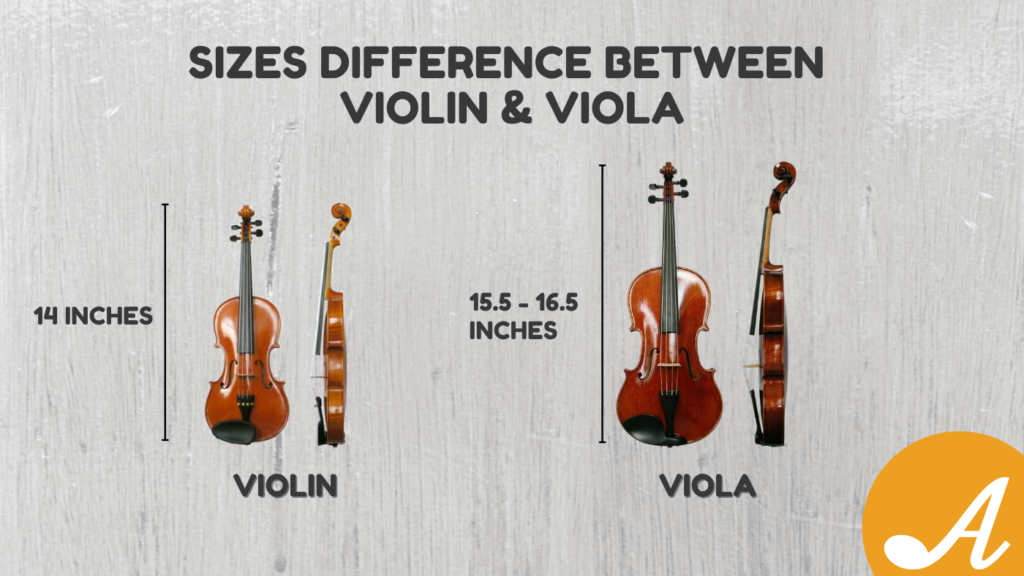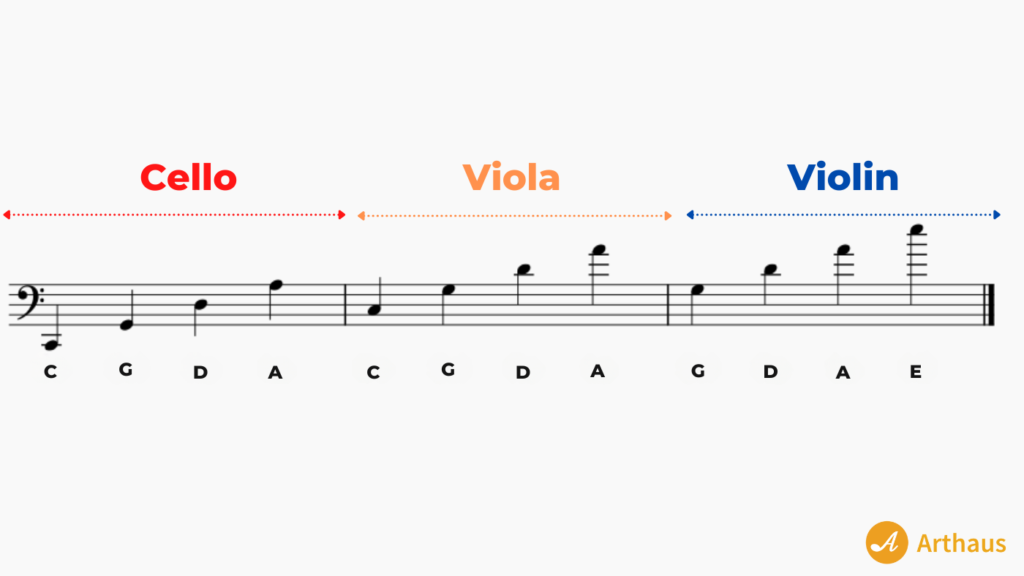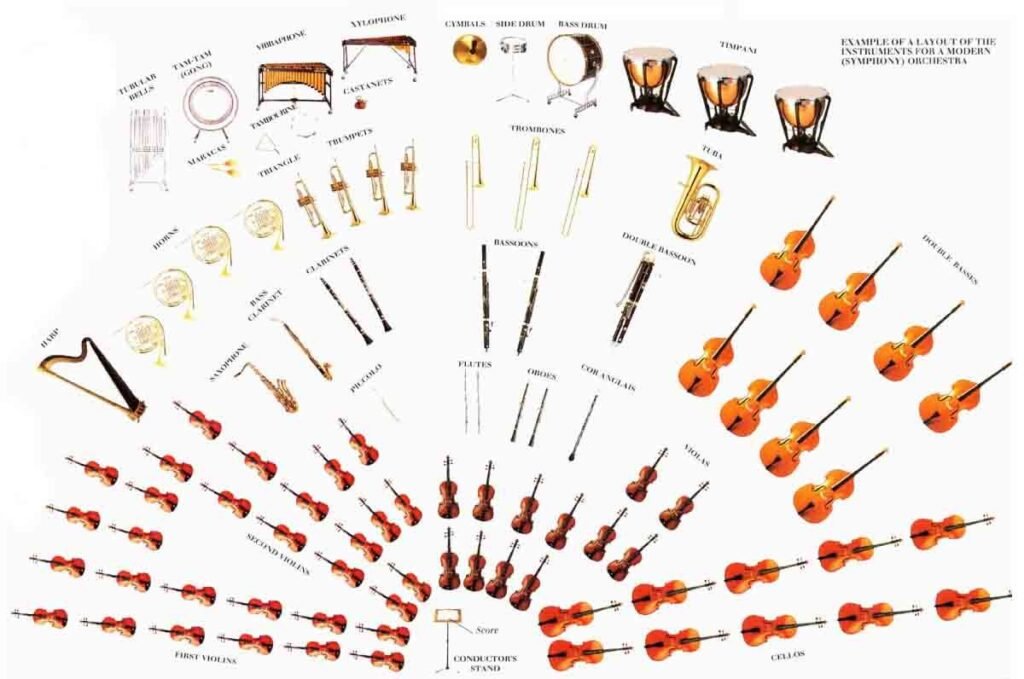The violin and the viola are very similar, and many people even confuse them, but several characteristics differentiate them both at a visual level and a performance level, to the point that if a violinist wanted to start playing the viola he would have to relearn some techniques, mainly in sound production.
But they’re not unknown either. Let’s say they’re cousins, all within the same family of instruments: bowed string instruments, which also include the cello and double bass.
Violinists can be violists and vice versa, we just need to be clear about what adjustments we must make to transform the technique built on our instrument into its opposite.
We will review 5 main characteristics that differentiate the viola from the violin.
The Different Sizes of the Violin vs. the Viola

The main difference between a viola and a violin is, at first glance, the size. Violins come in different sizes depending on the age of the player. The largest size is 4/4, which is used from age 12 onwards. For younger children, there are many options, even for children as young as 3. Here is a table showing the respective sizes and the appropriate age for each one.
| Violin Size | Distance from neck to hand | Age of the violinist |
| 1/16 | From 13.8 to 15.0 inches | From 3 to 4 |
| 1/10 | From 15.4 to 16.5 inches | From 4 to 5 |
| 1/8 | From 16.9 to 18.1 inches | From 5 to 6 |
| 1/4 | From 18.5 to 20.1 inches | From 6 to 7 |
| 1/2 | From 20.5 to 22.0 inches | From 7 to 8 |
| 3/4 | From 22.4 to 23.6 inches | From 9 to 11 |
| 4/4 | More than 23.6 inches | More than 11 |
Not to mention the smallest violin in the world, because that one is quite different even from a 1/16 scale violin. But when we talk about violin measurements, we always have the same proportions: a 4/4 violin has a body measuring about 356 mm (to find out what a body is, you can read this article about the parts of a violin), a 3/4 violin has a body measuring 330 mm, a 1/2 violin has a body measuring 300 mm, and so on.
But in the case of the viola, the smallest sizes are already quite large compared to the violins.
| Viola size | Distance from neck to hand | Age of the violist |
| 305 mm | From 20.9 to 21.7 inches | From 6 to 7 years old |
| 330 mm | From 21.7 to 23.2 inches | From 7 to 9 years old |
| 356 mm | From 23.2 to 24.8 inches | From 9 to 12 years old |
| 381 mm | From 24.8 to 25.6 inches | From 10 to 12 years old |
| 394 mm | From 25.6 to 26.4 inches | Adult |
| 406 mm or 419 mm | More than 26.4 inches | Adult |
The viola suitable for a child between 10 and 12 years old is already larger than the violin used by adults. We always advise children who want to play the viola, who are convinced they want to (until we show them the benefits of the violin), that in those cases it’s better to use viola strings on a 4/4 violin than to have them play on a small viola, which is also harder to find.
How Much Does a Viola Weigh Compared to a Violin?
As for weight, a 4/4 violin can weigh around 460 grams, while an adult viola weighs about 580 grams. I understand that this doesn’t seem like much of a difference, but those extra 120 grams, if you practice four or five hours a day, I assure you, make a difference.
I play both instruments, and the difference in size and weight is noticeable. From how we think about finger spacing to position changes, sound production, and other factors, we’ll explore below.
Tuning and Notes of the Viola and Violin
The second major difference between these two instruments is their tuning. The viola and the violin, like all bowed string instruments, share a common number of strings—four each—but their tuning is the major difference that distinguishes them within an orchestra, chamber orchestra, or quartet.
The tuning of the violin strings compared to the viola is as follows:
| Rope | Violin Notes | Viola Notes |
| 1st String | E | A |
| 2nd String | A | D |
| 3rd String | D | G |
| 4th String | G | C |
Range of the Viola vs Violin and Cello
If we compare the strings of the viola with those of the cello, the viola is the intermediate instrument between the violin and the cello. If we place the strings of the cello, viola, and violin in a bass clef, the viola is already within the same sonority range as the cello, which, despite having the same string names, are separated by an octave.

The difference is that the cello’s body and strings are larger, giving it a more powerful sound than the viola’s. Which brings us to the next difference.
Sound of the Violin and Viola
The violin is the highest-pitched instrument in the orchestra. Its first string can reach very high notes, which also gives it a wide range of pitches, since from its lowest string G, every one of the violin’s notes, passing through the different positions of the violin, have an unparalleled clarity that makes it an important piece in the orchestra.
The range of the violin is such that all the violinists in the orchestra are separated into two groups, the first violins, which are usually in charge of the higher parts, and the second violins, responsible for the slightly lower parts. At times, this is even the other way around, but the usual thing is that the first violins are high and the second violins are less high.

In the case of the viola, there is only one row in the orchestra, just as with the cellos, and this is because violas in orchestras have an accompanying role, “filling” the harmonic spaces between the melodies of the violins and the bass notes of the cellos and double basses.
The viola rarely plays a leading role in the orchestra, with a prominent solo or melodic part. Its deep, but not too deep, sound makes it a great support for the harmony. It’s a more beautiful instrument to listen to than the violin, as its low notes are warmer and less strident than the violin’s high notes.
Different Musical Keys
Let’s go back to the same table where we compared the pitches of the violin, viola, and cello strings from the bass clef. This is the clef cellists usually read because, as we can see, the cello has its four strings within the staff.
But on the viola and violin, all the notes are far outside the staff, this happens because the bass clef is not the usual clef for these instruments.
The viola reads the C clef on the third line and sometimes reads in the treble clef when the notes are very high, while the violin only reads in the G clef.
Compared to the previous table, the strings of each instrument with its key were as follows:

More Technical Differences to Consider
Although both are supported on the shoulder, the bow is held in the same way, and the left-hand rests on the handle in the same way, there are small details in the technique that must be taken into account when switching from one instrument to the other.
Bow weight
The viola bow is slightly heavier than the violin’s, as the viola’s strings, in addition to having a lower string than the violin’s, are thicker, so a little more effort is required to project a clear, clean sound. This extra weight means we have to lower our wrist and elbow a little more when drawing the bow, to transfer more weight from our arm to the bow.
Distance between notes
While on the violin we can make a semitone by touching one finger with another, on the viola if we touch one finger with another, the semitone will be a little out of tune, so especially in the first position we have to adjust the distances a little unlike on the violin.
Already in the third position on the viola, it is very similar to the first position on the violin, the hand begins to feel more comfortable in the distance between the notes.
Separation of the strings
The bridge is a little larger than that of the violin, which makes the separation between the strings greater, so the movement of the arm to reach from the first to the fourth string is a little greater, and in turn the distance of the strings to the fingerboard, that is, the pressure of the finger so that the string sounds clearly when resting the fingers.
This doesn’t mean that if you want to learn to play the violin, it will be very difficult to play the viola later on. Quite the contrary, they are very similar instruments with few differences between them, so it’s not that complicated to make the change.
Violin or Viola, Which is Best for Me?
You already know that there are many differences as well as similarities between these two instruments, but if you are just starting out on this path of learning some of these instruments, we recommend you consider the following:
- Your age: It will define the size of the instrument
- Your affinity for one or the other: Violin higher in pitch, viola lower in pitch, and less strident in pitch.
- The music you want to play: While music can be tuned to play on one instrument or another, most music is written for either treble or bass clef, while the viola plays primarily in the C clef.
If you’re looking for free violin or viola lessons, you can follow us on our YouTube channel, where you’ll find a step-by-step violin course to help you gradually master this instrument.

